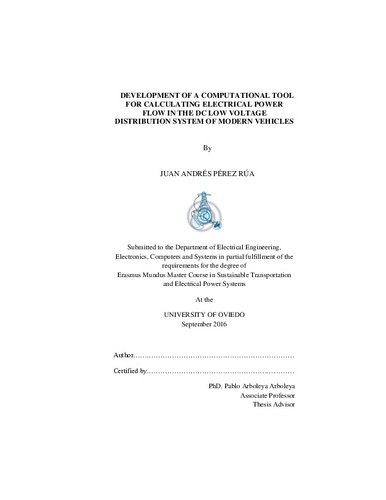Development of a computational tool for calculating electrical power flow in the DC low voltage distribution system of modern vehicles
Autor(es) y otros:
Director(es):
Palabra(s) clave:
Data organization
Automotive modularity
Wiring harness optimization
DC power flow
Fecha de publicación:
Serie:
Máster Universitario Erasmus Mundus en Transporte Sostenible y Sistemas Eléctricos de Potencia (EMMC STEPS)
Descripción física:
Resumen:
In this research work is embodied the result of gathering information and the establishment of a general procedure by which the manufacturing data of the on-board network distribution system of modern vehicles are adapted to a proposed format, in order to perform electrical power flow simulation on the aforementioned system. First at all, the state of the art information related to the philosophy and manufacturing procedures of the wiring systems currently applied by the Volkswagen Group are deployed. Secondly, the data organization system is described from scratch in accordance to the official practices of the Group. Later, the proposed data input format for an external power flow solver-visualization tool is explained in details along with coded routines in MATLAB to get them automatically parting from structures formed in pre-processing stages. Finally, it is tackled a descriptive analysis regarding the mathematical approaches available in the literature to solve linear systems defined by DC resistive networks such as the onboard distribution systems of vehicles; as result of this study, a method based in the graph theory of cyclic-direct pair-wise graphs is proposed as main algorithm to solve the electrical power flow of these systems: the Meshed Network Back and Forward Sweep method, which has been applied to static distribution networks and even to train systems, is newly explored from a point of view of applicability to the nature of the on-board distribution systems of modern vehicles; the advantages respect other methods based in mathematical techniques of the linear algebra field are listed and a test is carried out by means of an exemplification of the network. The main contributions of this work is the settling of a general procedure and methodology with aims of simulating the full electrical system of vehicles based in a modular wiring system design approach, which will help thoroughly to the improvement of the current techniques used by the designers when sizing wires and fuses in the department of electrical and electronic development in SEAT
In this research work is embodied the result of gathering information and the establishment of a general procedure by which the manufacturing data of the on-board network distribution system of modern vehicles are adapted to a proposed format, in order to perform electrical power flow simulation on the aforementioned system. First at all, the state of the art information related to the philosophy and manufacturing procedures of the wiring systems currently applied by the Volkswagen Group are deployed. Secondly, the data organization system is described from scratch in accordance to the official practices of the Group. Later, the proposed data input format for an external power flow solver-visualization tool is explained in details along with coded routines in MATLAB to get them automatically parting from structures formed in pre-processing stages. Finally, it is tackled a descriptive analysis regarding the mathematical approaches available in the literature to solve linear systems defined by DC resistive networks such as the onboard distribution systems of vehicles; as result of this study, a method based in the graph theory of cyclic-direct pair-wise graphs is proposed as main algorithm to solve the electrical power flow of these systems: the Meshed Network Back and Forward Sweep method, which has been applied to static distribution networks and even to train systems, is newly explored from a point of view of applicability to the nature of the on-board distribution systems of modern vehicles; the advantages respect other methods based in mathematical techniques of the linear algebra field are listed and a test is carried out by means of an exemplification of the network. The main contributions of this work is the settling of a general procedure and methodology with aims of simulating the full electrical system of vehicles based in a modular wiring system design approach, which will help thoroughly to the improvement of the current techniques used by the designers when sizing wires and fuses in the department of electrical and electronic development in SEAT
Colecciones
- Trabajos Fin de Máster [5283]
Ficheros en el ítem





